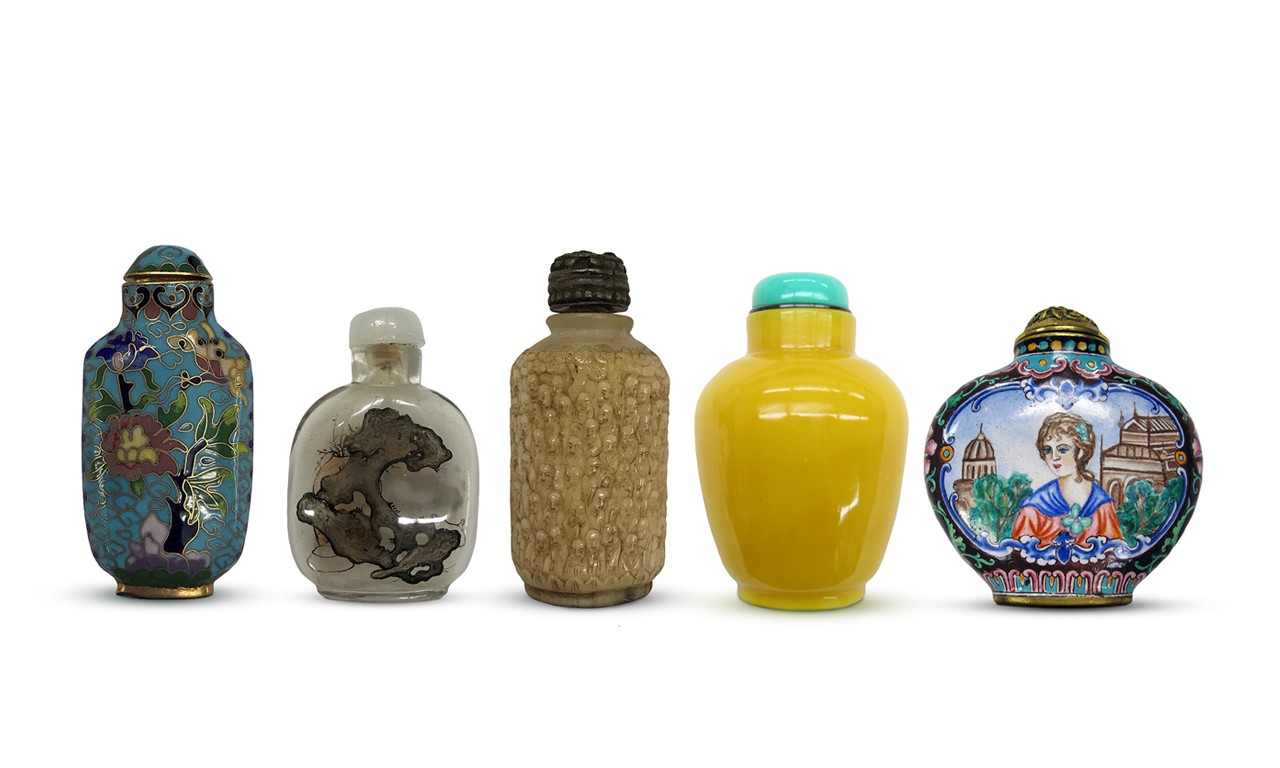 |
Snuff Bottles, 19th to 20th Century
Han culture; China
Various mediums
97.11.52.1-.2, 97.11.65.1-.2, 98.56.14a,b, 98.56.27a,b, and 99.71.100.1-.2
Gift of Dr. Murray and Brett Via |
No-Smoking Policy
Tobacco was first brought to China around the turn of the 17th century. Portuguese Jesuit missionaries entering the country to proselytize often brought tobacco with them for personal consumption and to trade with dignitaries. As early as 1636, smoking tobacco was already prevalent throughout China and just three years later considered enough of a nuisance that the Chongzhen Emperor (r. 1627-1644) created an edict banning smoking under penalty of losing the part of the body used to smoke, i.e., one’s head. Historians have pointed out that this law was hardly effective at slowing the spread of smoking tobacco in China—it happens that it was just the first of many such laws—but its ban in the imperial court may have spurred the popularity of other means of consuming tobacco such as chewing, the mixing of tobacco with opium to create an incredibly powerful substance called madak, and the subject of this post: snuff. Here we look at a selection of snuff bottles in the Bowers’ collections.
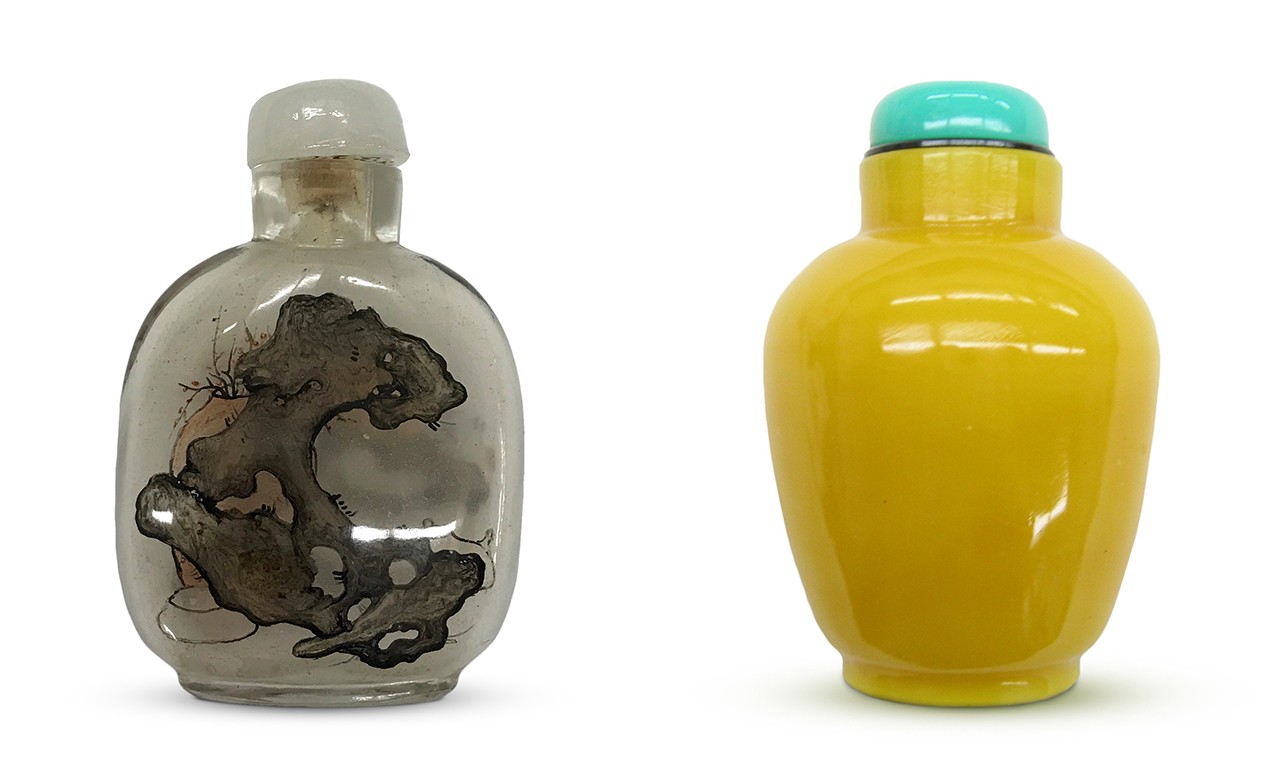 |
Snuff Bottle, 19th Century
Han culture; China
Glass and paint; 2 1/2 × 2 × 3/4 in.
98.56.27a,b
Gift of Dr. Murray and Brett Via |
Snuff Bottle, late 19th Century
Han culture; China
Peking glass; 3 1/2 × 2 1/4 × 2 1/4 in.
97.11.65.1-.2
Gift of Dr. Murray and Brett Via |
Expedited Expiration
Snuff spans the spectrum of being both easy and hard on the nose. It is a nice-smelling mixture of pulverized tobacco leaves and—at least in China—spices, herbs, and other aromatics. It is primarily ingested nasally which as a stimulant gives the user a pleasant sensation but in many cases triggers sneezing episodes. Modern science has further confirmed that long-term use also leads to a chronic inflammation of the nose. It first originated among the indigenous peoples of modern-day Brazil and due to colonial efforts lagged in crossing the globe only a short way behind smoking tobacco. Those first Jesuit missionaries into China often preferred snuff, but quickly encountered an issue with their European snuff boxes. The country’s high humidity caused snuff to clump when exposed to open air, quickly making the substance unsnortable. The earliest recorded Chinese snuff bottles were an effort to combat this issue and had small openings which could be sealed with cork lids. The first known example of this type dates to 1644, the first year of the Qing dynasty.
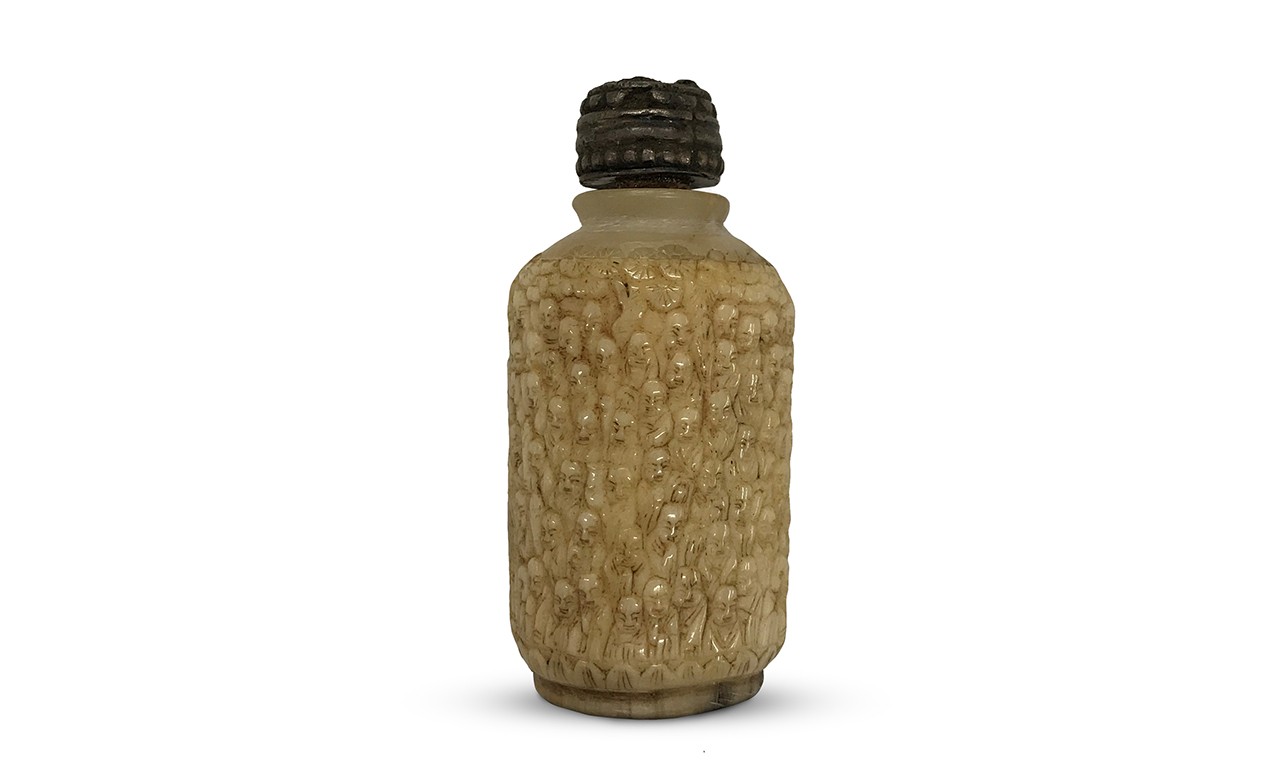 |
Snuff Bottle, 19th Century
Han culture; China
Jade and metal; 2 1/4 × 2 1/4 × 1 in.
98.56.14a,b
Gift of Dr. Murray and Brett Via |
Snuffing to Joke About
There were a great many patrons of snuff among Chinese emperors but perhaps the best known are the Kangxi Emperor (r. 1661-1722) and the Qianlong Emperor (r. 1735-1796). The former created workshops within the Forbidden City dedicated to the production of snuff bottles which created a sort of arms race for artisans to produce the most beautiful examples. The latter oversaw a golden age for snuff bottles as it was during his reign that its recreational usage surpassed what had primarily been a medicinal use in curing headaches, coughs, asthma, intestinal issues, and more. The result is that through to the end of the Qing dynasty snuff paraphernalia was pervasive and highly aestheticized whether through its shape, material and resultant color, carving, or painting.
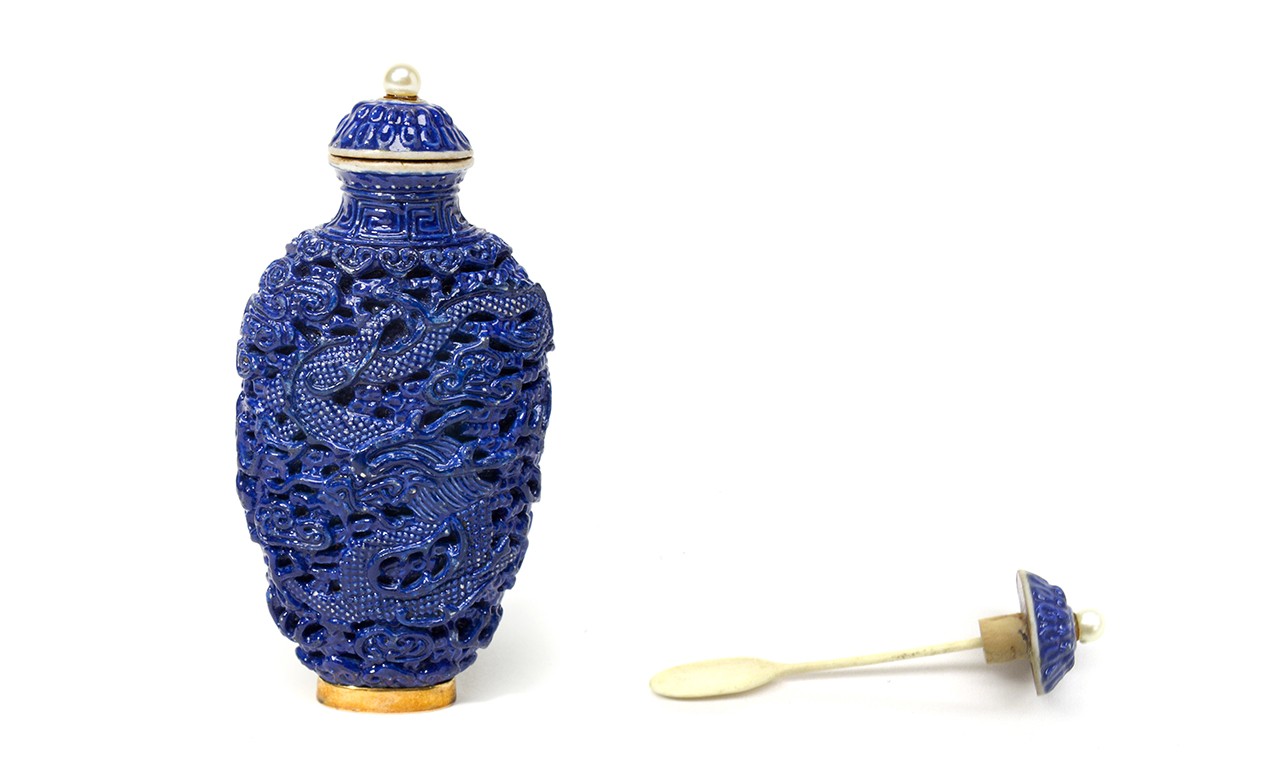 |
Snuff Bottle with Stopper, 19th Century
Han culture; China
Porcelain, metal and pearl; 3 3/8 × 1 1/2 × 1 in.
97.11.62.1-.2
Gift of Dr. Murray and Brett Via |
A-Glazing Grace
The Bowers examples demonstrate just a fraction of the techniques that were used in making snuff bottles. Industries existing in China well before tobacco came to Eurasia were employed in the creation of the vibrant blue porcelain bottle with dragon and phoenix motifs and in the bottle decorated with enameled peonies. The same can be said of the carved jade bottle as Chinese jade carvings date back to Neolithic times. Interestingly, it is the glass bottles that demonstrate significant strides in Chinese technology. Though Chinese glassmaking also has ancient roots, the glass bottles in this post feature two innovations which would not have been possible without Jesuit missionaries. In 1696 the Kangxi Emperor ordered the creation of another imperial workshop for glass. This one was overseen by Father Killian Stumpf for almost 20 years and produced examples of incredible quality. What is now called “Peking Glass” dates from this time and is defined by its vibrant colors—the yellow of this Bowers example was associated with the Qing emperor—and that it could be carved. Frosted glass bottles which had their interiors painted came about in the 18th century. Almost all bottles had a matching lid with a cork stopper from which a bone or ivory spoon was suspended.
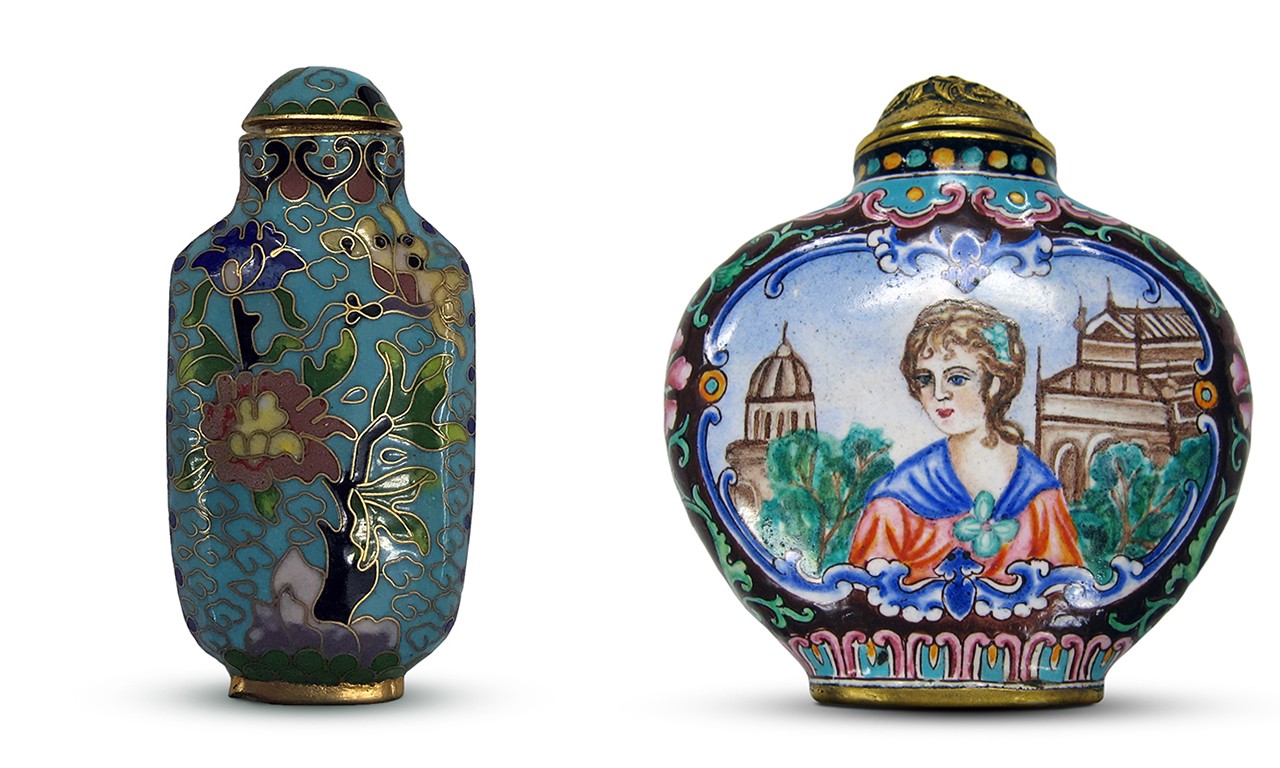 |
Snuff Bottle, 20th Century
Han culture; China
Cloisonné; 2 9/16 x 7/8 in.
99.71.100.1-.2
Gift of Dr. Murray and Brett Via |
Snuff Bottle, late 20th Century
European style; China
Metal, enamel and wood; 2 1/2 × 2 1/4 × 5/8 in.
97.11.52.1-.2
Gift of Dr. Murray and Brett Via |
Language of the Container
The almost universal rule that no motif is idly placed very much holds true in the iconography of these snuff bottles. Dragons and phoenixes are symbols of the emperor and empress respectively. Peonies represented wealth, power, and status. What has been called the “thousand Buddha” motif has appeared in various forms since the earliest days of Buddhism and might be an invitation to theological or philosophical thought much in the same way as the scholar’s stone would have been used, the decoration painted on the inside of one bottle. Even the enamel bottle with a European woman decorating each side is framed with bats (fu), a homonym in Chinese for “good fortune.”
Text and images may be under copyright. Please contact Collection Department for permission to use. References are available on request. Information subject to change upon further research.






Comments